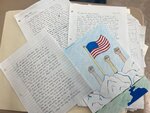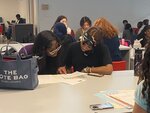Wednesday, May 1, 2024
Students recall 9/11 attacks by writing letters

John Buglione, a social studies teacher at Baldwin High School, wanted a creative way for his students to never forget the devastating attacks of Sept. 11.
He started teaching an inspiring lesson in his class right after the attacks, in 2001 and 2002, asking students to write “letters to the future” to describe how they felt and what they experienced on 9/11.
These images and letters now serve as primary sources for his current history students, as he asks them to read these artifacts, and to think of them as “primary sources” on the attacks. This is Buglione’s unique way of teaching historiography to his students.
“The next couple of days after 9/11, everybody just told their stories, because everybody knew someone who was affected by the attacks,” Buglione said. “So then it kind of clicked that I should get them to write down their stories.”
He said he figured that would be a good way for future generations to be informed about what people were going through at the time. Buglione continued with the lessons through 2003, and he eventually transformed them into having students write letters to their grandchildren, telling them what Sept. 11 felt like.
“As the years went by, my colleagues and I started to notice that students were getting more and more of a brain fog about 9/11,” Buglione said. “So it was interesting to gradually see memory turn into history.”
Buglione altered the lessons again when he started teaching students who were born after Sept. 11, 2001. His students now read about what Baldwin teenagers in his classes before them wrote about 9/11. The lesson focuses on current students writing a story about how their predecessors were impacted.
Buglione started the lessons after he finished graduate school, where he studied oral history, laying the foundation for his evolving approach to teaching his students about Sept. 11 lessons. He studied how people created narratives about events in their lives, and two decades later, he is incorporating that into his instruction.
“On 9/11, I was doing these lessons because, at the time, there seemed to be a lot of teenage apathy towards politics,” Buglione said. “A lot of kids didn’t really feel like they had any control over politics, or they didn’t feel like it was really worthwhile to do things like vote.”
That sense of apathy changed after the attacks, according to Buglione. He saw his students become more united, as they shared similar experiences about the tragedy in Lower Manhattan and its aftermath.
“When students read the letters today, they’re struck by how there was an intense patriotism by everybody,” Buglione said. “There’s this theme that runs through a lot of the letters that 9/11 was a turning point.”
Some of his students have been so inspired by these letters that they wanted to help their community. A few said they were going to join the U.S. Army, and most of them mentioned ways that they wanted to make an impact on the people around them.
“My students were affected by watching people dig through the rubble, and somebody said they will go out and help someone,” Buglione said. “Someone else said that they’re going to make sure that they spend more time with their family.”
After watching video of the attacks and learning about the hundreds of people who didn’t make it home that day, some of his students said they wanted to have dinner with their families and spend more time with them, Buglione said.
“All of these little actions are really striking,” he said. “It’s very emotional to see people talk about things like that.”
HELP SUPPORT LOCAL JOURNALISM
The worldwide pandemic has threatened many of the businesses you rely on every day, but don’t let it take away your source for local news. Now more than ever, we need your help to ensure nothing but the best in hyperlocal community journalism comes straight to you. Consider supporting the Herald with a small donation. It can be a one-time, or a monthly contribution, to help ensure we’re here through this crisis. To donate or for more information, click here.
Sponsored content
Other items that may interest you









